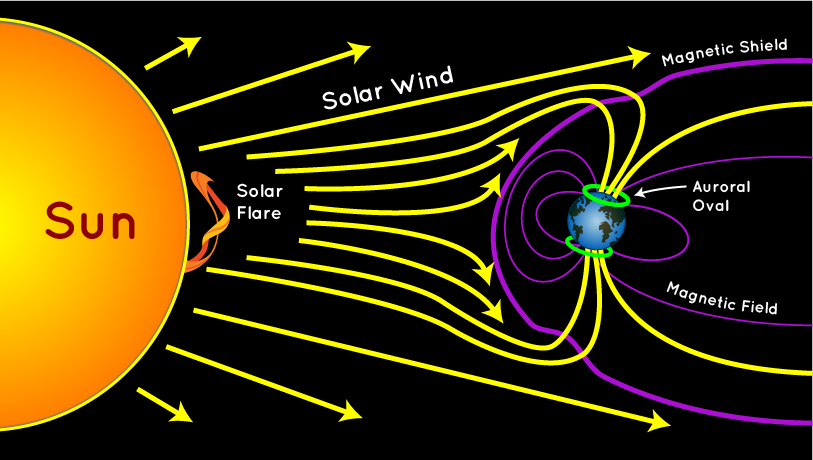Our planet is a witness to multiple natural phenomena – biological, chemical or optical. Aurora is primarily some gorgeous physics at play – but we’d also classify it as an optical phenomenon. Predominantly observed in high latitude regions, regions possessing a weak magnetic field, auroras are a natural light spectacle in the sky. Imagine it as a colourful sunset swirling across a clear sky.
They’re well documented, and space and nature enthusiasts are well versed with them. The colours of an aurora that can be detected by the human eye include red, green, yellow and blue. These colours are observed at different altitude levels – red observed at high altitude and blue observed at lower altitude. Apart from these observable colours, ultraviolet and infrared light can be observed using the required equipment.
Auroras can be observed at locations above 60o latitude. When observed in northern latitude, the effect is called Aurora Borealis, named after Boreas, the Greek name for the north wind. Canada and the Scandinavian countries are the best places to watch the Northern Lights. The southern counterpart of the Aurora Borealis is called Aurora Australis. Southern lights are best viewed from South America and Australia. Since the southern pole is less populated than the northern pole, the lights are commonly referred to as Aurora Borealis.
But what causes auroras in the first place?
The Physics behind Auroras
The physics behind the auroras is as fascinating as the aurora itself. Openings in the Sun’s atmosphere allow charged particles – electrons and protons, to flow out. These charged particles travel at extremely fast velocities towards the Earth, carried by what we call solar winds. Now the Earth happens to have a magnetic field of its own – the same field that helps align our compasses. This magnetic field acts as a barrier for the planet, and deflects most of the charged particles.
At the poles however, the magnetic field is weaker. This allows the charged particles to breach Earth’s atmosphere. When these charged particles interact with the gaseous particles in our atmosphere, an aurora shows up in our skies. The charged particles have enough energy to knock off the gas atoms in our atmosphere – this causes the atoms to give off light, and eject more charged particles. Result? Aurora.

The variation in colours of auroras is observed based on the type of gaseous particles, usually oxygen. The color depends on the gas atom that’s knocked off in the atmosphere:
- Green – oxygen, 0 – 150 miles altitude
- Red – oxygen, 150+ miles altitude
- Blue – nitrogen, 0-60 miles altitude
- Purple/violet – 60+ miles altitude
The red coloured aurora is formed at higher altitudes where the concentration of oxygen is less. This is the reason red coloured aurora is very rare. To add to that, our eyes are less sensitive to this wavelength making it more difficult to observe it. With reducing altitude, oxygen concentration spikes up – this causes the more common green coloured auroras.
Interpretations
The lights obviously provide a sense of awe, but unsurprisingly, they’ve also become a source of superstition. Cave paintings in France dating back 30,000 years feature aurora illustrations. Before humans figured out how auroras work, different civilisations ended up with varying interpretations of the lights. The Inuit of Alaska considered the lights as the dancing souls of seals, salmon and beluga whales. The Swedes and Scots considered the lights just as merry dancers. To the Chuvash people of Central Asia, it was the deity called upon to ease women through their labour pains. The Lakota tribe from North America considered it to be spirits of the future generations waiting to be born.

Even after the scientific reason as to why the lights appear has been identified, people are still known to follow popular beliefs. Japanese couples visit Northern Canada believing children conceived under the lights will be more fortunate. Scandinavian fishermen consider the lights as an omen of abundance.
Can we see the true colours of the lights?

If you’re heading out to witness auroras first hand based on the pictures you’ve seen all over the internet, you may be in for some disappointment. In real life, the colours that we perceive when we view the lights are generally shades of grey and white. At the same time if a photo of the lights is captured using a DSLR, multiple different colours – reg, green and blue – are captured.
To understand why this happens, we need to delve in deeper into the functioning of the human eye. There are two types of cells in our eyes – cones and rods. Cone cells detect colour in bright light, while rod cells detect fainter colours in the dark which are viewed as black, white or shades of grey. Since we observe aurora lights only at night, our eyes can’t perceive the vibrant colours, limiting our perspective to shades of grey.
The dynamic range of a DSLR camera is much higher than our human eye. Additionally, all the gorgeous photos we see are thanks to the increased exposure time on these cameras, which help reveal the true colours of these auroras.
